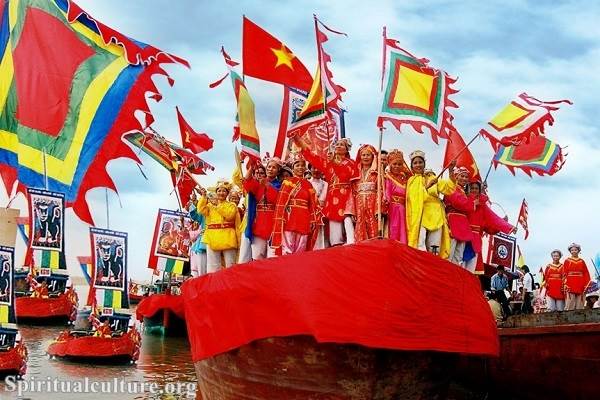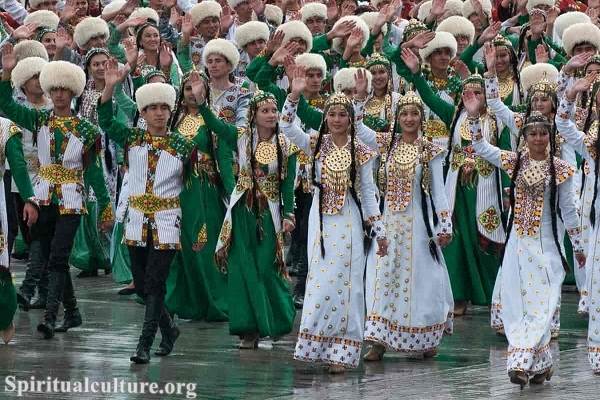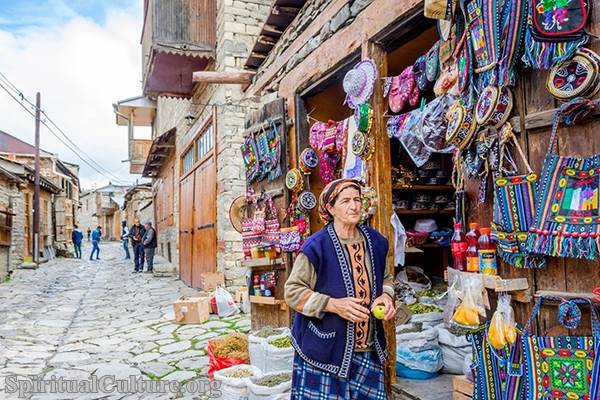The cultural landscape of Canada, or Turtle Island as it is known to many Indigenous peoples, is rich with millennia of human history, spiritual practices, and indelible connections to the land. As of the Current Time of Writing, there is a global and domestic commitment to the principles of reconciliation and the elevation of First Nations, Inuit, and Métis voices, which has brought these sites into sharper focus than ever before. These cultural locations are not mere historical remnants; they are living libraries that teach profound lessons about ecology, community, and the human spirit’s endurance.
At Spiritual Culture, we approach this Top 10 list with reverence, recognizing that the “fame” of a site is inextricably linked to its deep spiritual impact, historical authenticity, and the continuous stewardship by the Indigenous Nations who call these places home. Our ranking is evidence-based, drawing upon criteria such as UNESCO World Heritage status, archaeological depth, and the site’s ongoing role in maintaining cultural continuity and spiritual tradition.
We move beyond tourism figures to explain the spiritual meaning woven into the very fabric of the landscape, celebrating these locations as vital conduits to understanding the foundational spiritual cultures of North America. These sites stand as powerful testaments to the sophisticated knowledge systems that predate colonization, offering invaluable insights for contemporary spiritual seekers and historians alike.
Table of the Top 10 Most Famous Indigenous Cultural Sites in Canada with Spiritual Influence
| Rank | Site Name | Location | Primary Indigenous Nation(s) | Historical/Spiritual Significance | UNESCO Status |
|---|---|---|---|---|---|
| 1 | SG̱ang Gwaay (Ninstints) | Haida Gwaii, BC | Haida | Preserves the world’s most impressive collection of 19th-century carved memorial poles, representing the Haida spiritual connection to ancestry and territory. | Cultural (1981) |
| 2 | Head-Smashed-In Buffalo Jump | Southern Alberta | Blackfoot (Piikani, Kainai, Siksika) | Site of communal bison hunting for nearly 6,000 years, embodying a profound spiritual relationship with the Bison and sophisticated communal ceremony. | Cultural (1981) |
| 3 | Writing-on-Stone / Áísínai’pi | Southern Alberta | Blackfoot Confederacy (Niitsitapi) | North American Plains’ largest concentration of ancient Indigenous rock art (petroglyphs and pictographs), a sacred landscape for communication with the spirit world. | Cultural (2019) |
| 4 | Wanuskewin Heritage Park | Saskatoon, Saskatchewan | Plains Indigenous Peoples | An ancient site of gathering and ceremony with archaeological findings spanning over 6,000 years, currently pursuing World Heritage status. | Tentative List (Cultural) |
| 5 | Pimachiowin Aki | Manitoba/Ontario | Anishinaabeg (Ojibwe) | “The Land That Gives Life,” a vast boreal forest cultural landscape demonstrating the Anishinaabe cultural tradition of Ji-ganawendamang Gidakiiminaan (“keeping the land”). | Mixed (2018) |
| 6 | L’Anse aux Meadows National Historic Site | Newfoundland and Labrador | Mi’kmaq/Innu (Pre-Columbian connection to land) | While famed for Vikings, the site sits on land with millennia of prior Indigenous use, which frames the subsequent history and cultural interactions. | Cultural (1978) |
| 7 | Haida Gwaii (Gwaii Haanas National Park Reserve) | Haida Gwaii, BC | Haida | A protected area co-managed by the Haida Nation and Parks Canada, encompassing ancient village sites, burial caves, and a deep spiritual connection to the ocean. | N/A (National Park Reserve) |
| 8 | Tr’ondëk-Klondike | Yukon Territory | Tr’ondëk Hwëch’in First Nation | Landscape demonstrating the adaptability and resilience of the Tr’ondëk Hwëch’in people during and after the unprecedented disruption of the Klondike Gold Rush. | Cultural (2023) |
| 9 | Old Crow Flats (Vuntut National Park) | Yukon Territory | Vuntut Gwitchin First Nation | A vital, ancestral home for the Gwich’in people, recognized for its unbroken ecological and cultural connection to the Porcupine Caribou Herd. | N/A (National Park) |
| 10 | Kejimkujik National Park and National Historic Site | Nova Scotia | Mi’kmaq | Home to Mi’kmaq petroglyphs, burial grounds, and waterways used by the Mi’kmaq for thousands of years, representing a sacred and continuous habitation. | N/A (National Historic Site) |
Top 10. Kejimkujik National Park and National Historic Site
Kejimkujik, known affectionately as “Keji,” is a significant national park in Nova Scotia that acts as a profound repository of Mi’kmaq history and spirituality. The park encompasses ancient travel routes, traditional gathering places, and over 50 Mi’kmaq petroglyph sites carved into the slate and quartzite outcrops along the lakeshores. These carvings depict people, animals, European sailing ships, and spiritual symbols, serving as an irreplaceable record of the Mi’kmaq way of life and their long-standing presence on the land, dating back millennia.
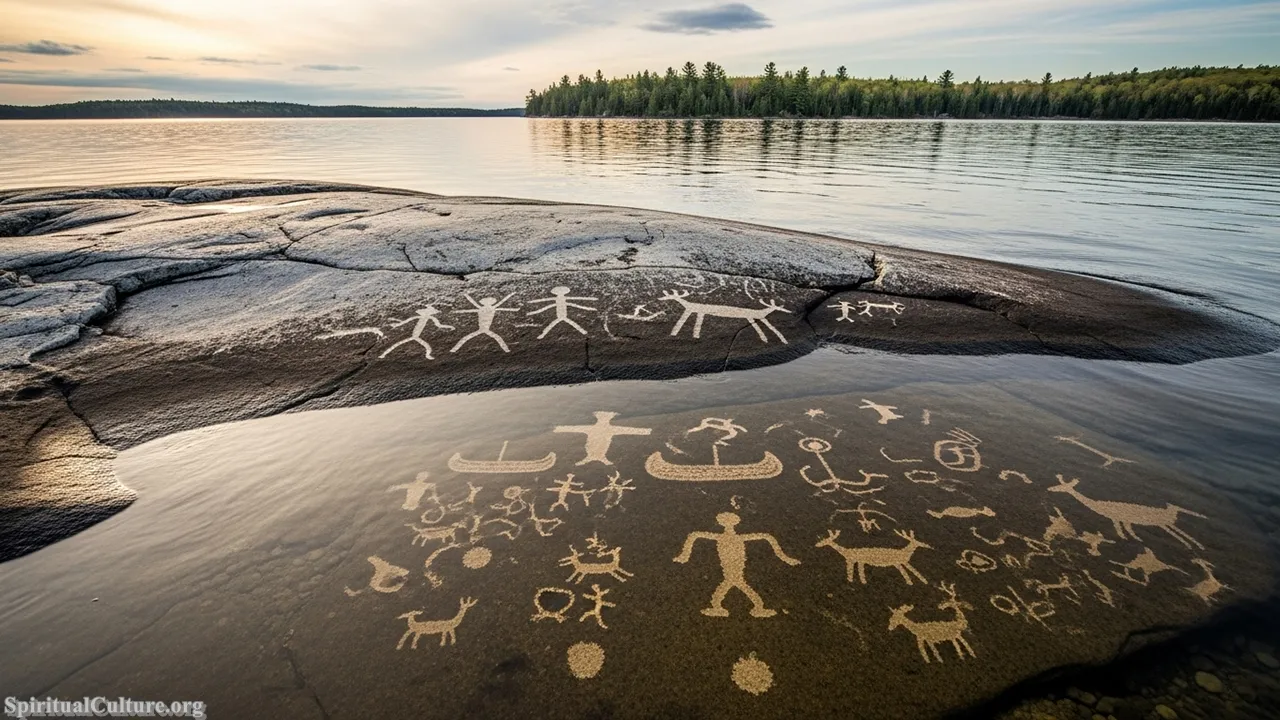
The site is a powerful example of living heritage, where the continuity of Mi’kmaq culture is evident in the landscape itself. The reason for its inclusion in this ranking lies in its unique concentration of petroglyphs and its spiritual role as an ancient cultural centre and burial ground. It underscores the deep spiritual connection the Mi’kmaq have to the waterways and forests of their ancestral territory, Mi’kma’ki, offering a tangible link to the knowledge and narratives passed down through oral tradition. The preservation of the park is a contemporary act of respect for the original caretakers of the land.
This site reminds us that spiritual connection is often rooted in the simple continuity of place and practice. It teaches a moral lesson in preservation: that protecting the natural world is simultaneously protecting human heritage. The subtle, yet powerful, legacy etched into the rocks at Keji encourages visitors to tread lightly and listen deeply, connecting to the enduring spirit of the Mi’kmaq Nation.
Cultural/Spiritual Highlights
- Irreplaceable Petroglyphs: Over 50 sites feature rock carvings detailing Mi’kmaq spiritual figures, history, and daily life.
- Ancient Waterways: The lakes and rivers are part of ancient canoe routes, reflecting a traditional connection to travel and trade.
- Cultural Continuity: The site is actively used by Mi’kmaq for cultural programming and education.
Top 9. Old Crow Flats (Vuntut National Park)
Old Crow Flats, situated within the vast Vuntut National Park in the northern Yukon, is an expansive wetland ecosystem and a core component of the Vuntut Gwitchin First Nation’s traditional territory. This region is a vital calving and summer habitat for the Porcupine Caribou Herd, the lifeblood of the Vuntut Gwitchin and other Gwich’in communities for thousands of years. The Flats contain archaeological evidence of human presence dating back more than 10,000 years, making it one of the oldest continually occupied regions in North America.

The reason for its high spiritual ranking stems from the unbroken, symbiotic relationship between the Vuntut Gwitchin and the caribou—a relationship founded on the spiritual principle that the fate of the people and the fate of the caribou are one. The traditional management systems and spiritual observances centered on the annual migration embody a pristine example of an Indigenous cultural landscape. As of the Current Time of Writing, the park is co-managed by the Vuntut Gwitchin, ensuring that the ancient spiritual protocols that govern the land remain paramount.
Old Crow Flats offers a profound reflection on the concept of sustainable living and the spiritual necessity of reciprocity. It is a powerful lesson in understanding that true “culture” is often a delicate and mutually respectful partnership between people and the non-human world. Protecting this remote wilderness is a global act of preserving a unique spiritual ethos where survival is intrinsically tied to respect for the animals.
Cultural/Spiritual Highlights
- Reciprocity: The Gwich’in spiritual tradition is centered on a sacred, interdependent relationship with the Caribou.
- Archaeological Depth: Contains some of the oldest evidence of human occupation in North America, dating back 10,000+ years.
- Active Co-Management: The park is jointly managed by the Vuntut Gwitchin First Nation, preserving Indigenous governance.
Top 8. Tr’ondëk-Klondike
Recently inscribed as a UNESCO World Heritage Site in 2023, the Tr’ondëk-Klondike represents the cultural landscape of the Tr’ondëk Hwëch’in First Nation, centered around the confluence of the Yukon and Klondike rivers near Dawson City. The site is a powerful testament to the resilience and adaptability of the First Nation who maintained their culture and spiritual connection to the land despite the catastrophic disruption of the late 19th-century Klondike Gold Rush.
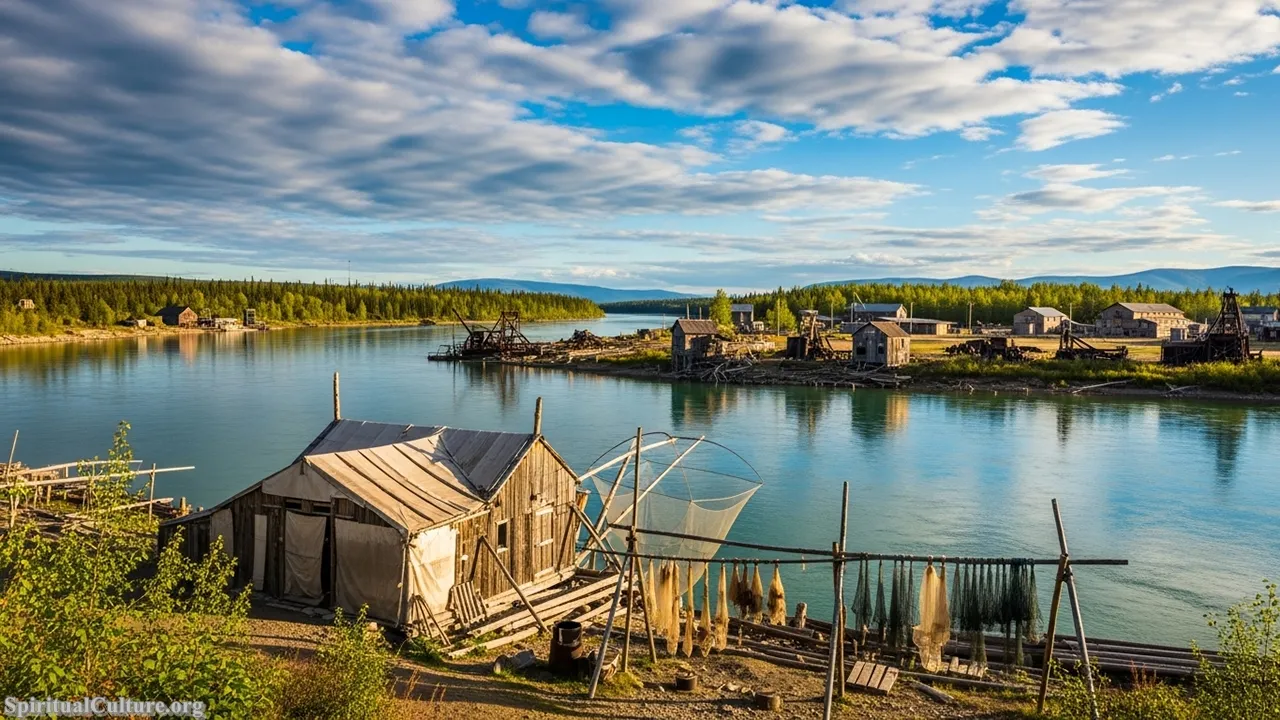
Its importance lies not just in the historical context of the Gold Rush, but in the spiritual and social strength of the Tr’ondëk Hwëch’in leadership who navigated that crisis. They sought to protect their traditional fishing and hunting grounds, establishing a new settlement nearby while ensuring their heritage endured. The ranking reflects the modern recognition of their ancestral territory and the sophisticated diplomacy required to preserve the core of their spiritual practices—the river and the salmon—amidst overwhelming societal change.
The Tr’ondëk-Klondike offers a vital lesson in resilience and the humanistic spirit. It teaches us that cultural survival is often an act of careful adaptation, diplomacy, and unwavering spiritual fortitude in the face of external pressures. The land and sites within this cultural landscape embody the strength of a people who successfully bridged the pre-contact world with the contemporary era.
Cultural/Spiritual Highlights
- 2023 UNESCO Inscription: Recognized globally for illustrating Indigenous adaptability during the Gold Rush era.
- Resilience Narrative: Highlights the Tr’ondëk Hwëch’in’s enduring connection to their ancestral land and the Yukon River.
- Patrimonial Sites: Includes fishing camps and meeting places that demonstrate pre- and post-contact lifeways.
Top 7. Haida Gwaii (Gwaii Haanas National Park Reserve)
The Haida Gwaii archipelago, and specifically the southern portion protected as Gwaii Haanas, is a breathtaking cultural and natural landscape jointly managed by the Haida Nation and the Government of Canada. More than just a park, Gwaii Haanas, meaning “Islands of Beauty,” is recognized by the Haida as an ancient, sacred place, containing the ruins of numerous former villages and burial caves. The unique model of co-management ensures the living culture of the Haida guides the stewardship of the land and sea.
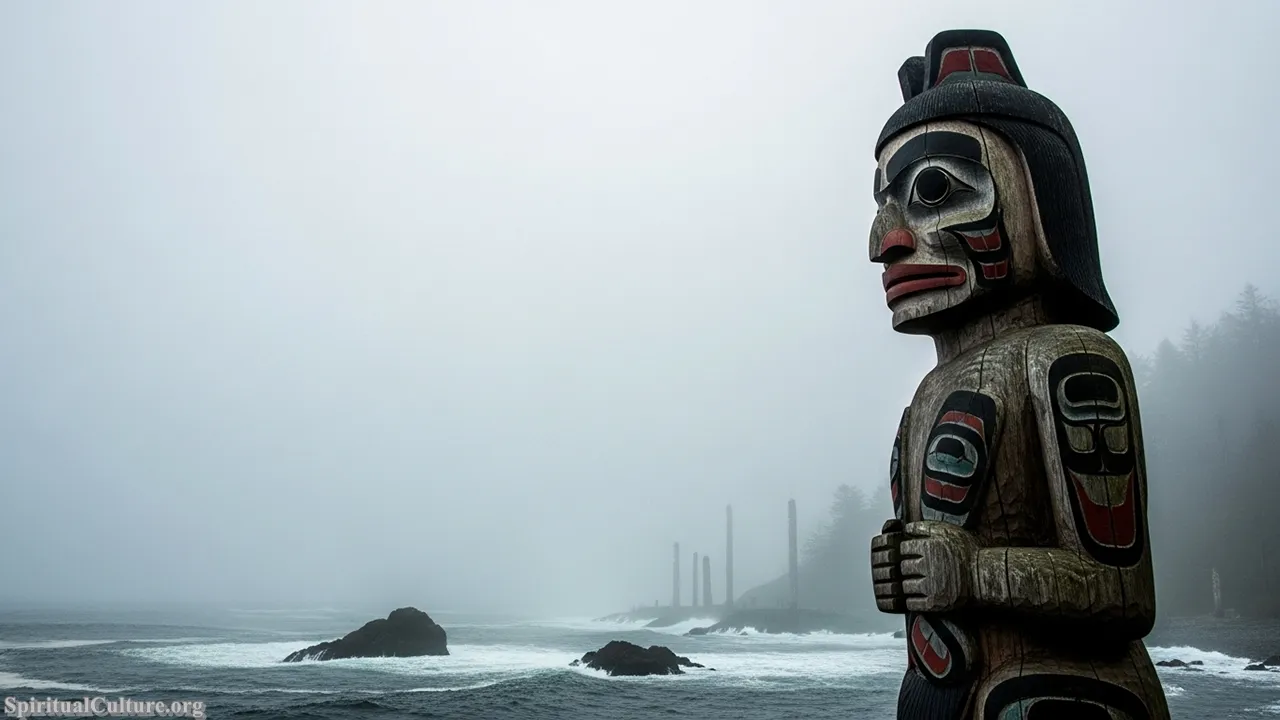
The spiritual impact of Haida Gwaii is immense, rooted in the Haida belief that the land, sea, and all creatures possess kil’ahl (a life force or spirit). This ranking is based on the comprehensive preservation of the Haida worldview—a spiritual tapestry of crests, stories, and protocols that govern every aspect of life. Though SG̱ang Gwaay (No. 1) is the core UNESCO site, the entire region is a vast cultural reserve that stands as a fortress of Haida spiritual identity, a model for Indigenous sovereignty and heritage protection worldwide as of the Current Time of Writing.
Haida Gwaii is a profound reflection on governance and spiritual ownership. The very act of co-management, guided by the principle of Yah’guudang (respect), teaches a moral lesson in collaborative preservation. It showcases that the most effective way to protect a cultural site is to entrust its care to the people whose spiritual lives have been intertwined with it for millennia, preserving both the tangible and intangible heritage.
Cultural/Spiritual Highlights
- Co-Management Model: Jointly governed by the Haida Nation, implementing Indigenous spiritual law and conservation principles.
- Living Tradition: The area is patrolled by Haida Watchmen, ensuring ancestral respect and cultural continuity.
- Sacred Geography: The entire region is considered sacred, embodying the deep interconnectedness of all life in the Haida worldview.
Top 6. L’Anse aux Meadows National Historic Site
L’Anse aux Meadows, famously known as the 11th-century Viking settlement, is included in this Indigenous cultural ranking due to its complex and ancient pre-contact history within Mi’kmaq and Innu territories. While the sod buildings of the Norse are the primary draw, archaeological findings demonstrate that the site was utilized by various Indigenous groups for thousands of years prior to the short-lived European arrival. This broader context frames the spiritual and cultural narrative of the land as an intersection point of deep history.
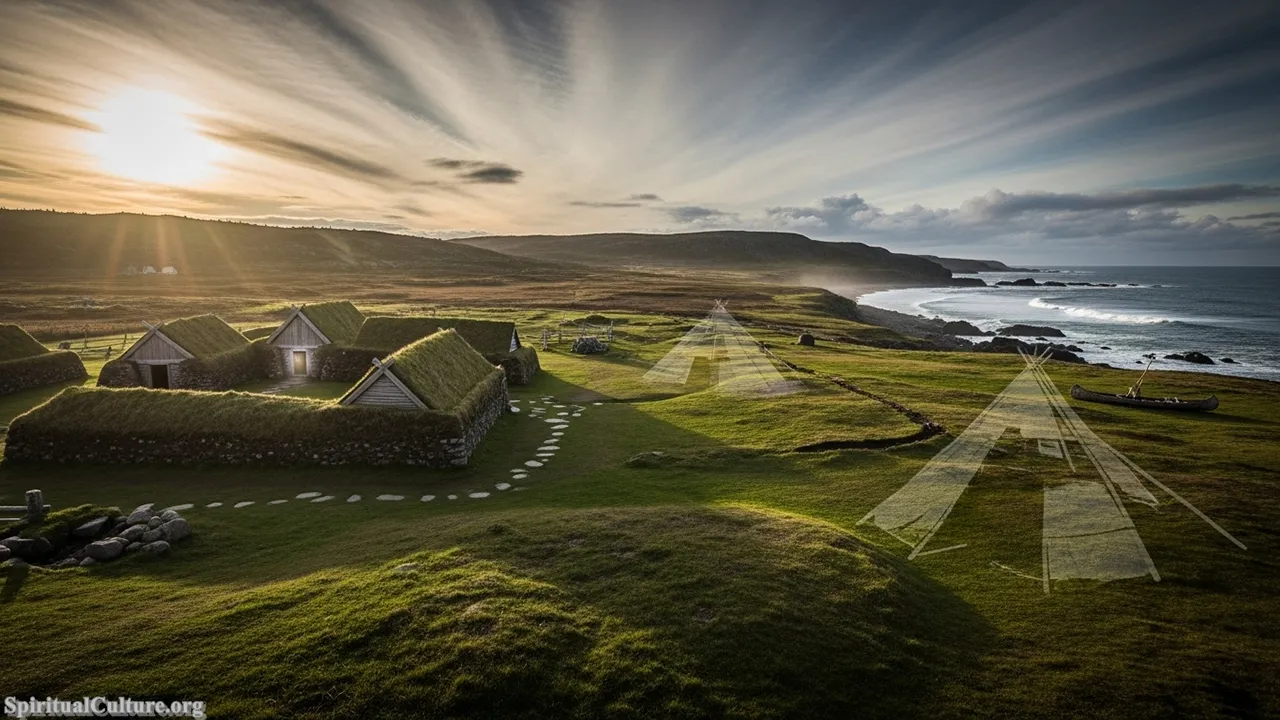
Its inclusion is justified by the understanding that a site’s spiritual importance is measured by the complete timeline of human interaction, not just the most recent or internationally “famous” layer. The land itself, long before the Vikings, was a place of spiritual sustenance for the Mi’kmaq, who possessed a profound and ancient connection to the coastal and marine environment. It serves as a stark reminder of the long-term Indigenous occupation that preceded and surrounded the European incursions, demanding a holistic view of Canadian heritage in the Current Time of Writing.
L’Anse aux Meadows offers a critical reflection on historical perspective, challenging the conventional narrative of European “discovery.” The preservation value lies in using the global recognition of the site to highlight the much longer, enduring spiritual and cultural legacy of the Indigenous Nations of Newfoundland and Labrador. It is a lesson in decolonizing history and recognizing the layers of deep spiritual meaning embedded in a single piece of land.
Cultural/Spiritual Highlights
- Deep Pre-Contact History: Archaeological evidence of Indigenous use of the area predates the Norse arrival by millennia.
- Intersection of Cultures: It is a unique place where Indigenous and European cultures first made contact (or near-contact) in the 11th century.
- Mi’kmaq Ancestral Territory: The site lies within the traditional spiritual lands of the Mi’kmaq and Innu.
Top 5. Pimachiowin Aki
Pimachiowin Aki, meaning “The Land That Gives Life” in Anishinaabemowin, is a vast boreal forest cultural landscape straddling the provincial borders of Manitoba and Ontario. Inscribed as a UNESCO World Heritage Site in 2018, it is a testament to the Anishinaabeg (Ojibwe) cultural tradition of Ji-ganawendamang Gidakiiminaan (“keeping the land”)—a spiritual management system that has preserved the land’s ecological and cultural integrity for over 7,000 years.
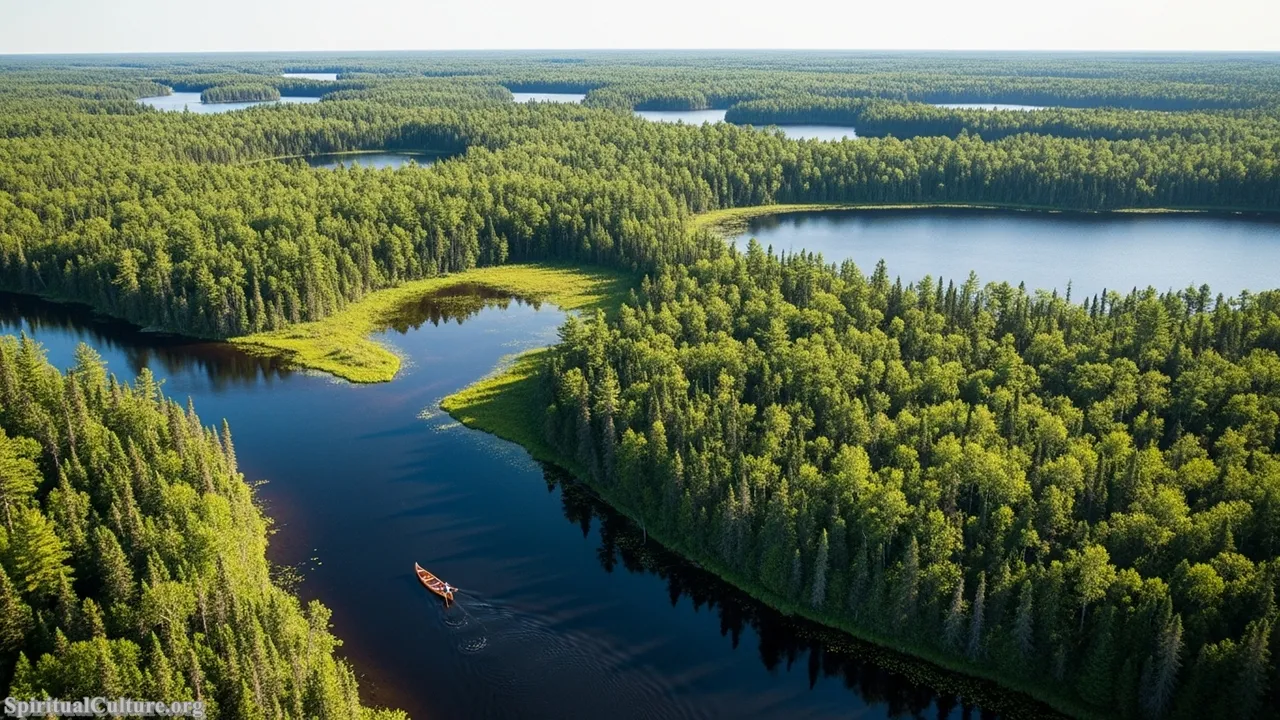
The site is ranked highly for its demonstration of a thriving, intact spiritual landscape co-created by people and nature. The deep spiritual value of Pimachiowin Aki lies in the intangible heritage of the Anishinaabeg, who view the land as the source of their life and law. The governance model is founded on the spiritual contract between people and the Creator, making this an unparalleled example of traditional ecological knowledge and spiritual principles actively managing a huge territory as of the Current Time of Writing. The UNESCO designation explicitly recognizes the cultural value of this traditional relationship.
Pimachiowin Aki is a powerful reflection on the true meaning of “sustainability” and “heritage.” It offers a profound moral lesson: that a spiritual perspective focused on stewardship and respect for all life can lead to environmental resilience and cultural longevity. The preservation of this pristine environment is the preservation of an ancient and profound spiritual management system, offering solutions to contemporary global environmental challenges.
Cultural/Spiritual Highlights
- Mixed UNESCO Status: Recognized for both cultural and natural criteria, highlighting the human-nature partnership.
- Ji-ganawendamang Gidakiiminaan: Embodies the Anishinaabe spiritual tradition of “keeping the land.”
- Intact Cultural Landscape: Represents one of the largest and best-preserved examples of boreal shield culture.
Top 4. Wanuskewin Heritage Park
Wanuskewin Heritage Park, located just outside Saskatoon, Saskatchewan, is an essential spiritual and archaeological site that speaks to the deep pre-contact history of the Plains Indigenous Peoples. The park encompasses Canada’s longest-running archaeological dig, with findings spanning over 6,000 years, including tipi rings, a medicine wheel, and bison jumps. It is a historic meeting place for various nations and a place of spiritual gathering and profound cultural exchange.

The reason for its high ranking is its intentional and ongoing role as a spiritual and cultural centre dedicated to reconciliation and education, coupled with the immense depth of its archaeological record. Currently on the UNESCO Tentative List, Wanuskewin is actively seeking full World Heritage status based on its 6,400-year history as a site of Indigenous spiritual and cultural convergence. This pursuit, highly supported in the Current Time of Writing, reinforces its significance as a globally important place of Indigenous antiquity and spiritual renewal.
Wanuskewin offers a reflection on the spirit of gathering and continuous connection. It teaches the lesson that sacred sites are not only historical, but living spaces for contemporary cultural practice. The preservation efforts here—including extensive cultural programming and the conservation of the Northern Plains ecosystem—demonstrate a powerful commitment to restoring and sharing the spiritual narratives that shaped the heart of North America.
Cultural/Spiritual Highlights
- 6,400 Years of History: One of the longest records of continuous Indigenous occupation in North America.
- Spiritual Gathering Hub: Contains ancient tipi rings and a ceremonial medicine wheel.
- UNESCO Tentative List: Actively pursuing World Heritage status, affirming its global cultural significance.
Top 3. Writing-on-Stone / Áísínai’pi
Writing-on-Stone Provincial Park, known in Blackfoot as Áísínai’pi (“it is pictured” or “written”), is a profoundly sacred landscape in southern Alberta. Inscribed as a UNESCO World Heritage Site in 2019, it holds the largest concentration of Indigenous rock art on the North American Plains. Thousands of petroglyphs (carvings) and pictographs (paintings) adorn the sandstone cliffs and hoodoos, illustrating over 3,500 years of the spiritual lives, wars, and ceremonies of the Niitsitapi (Blackfoot) and other Nations.
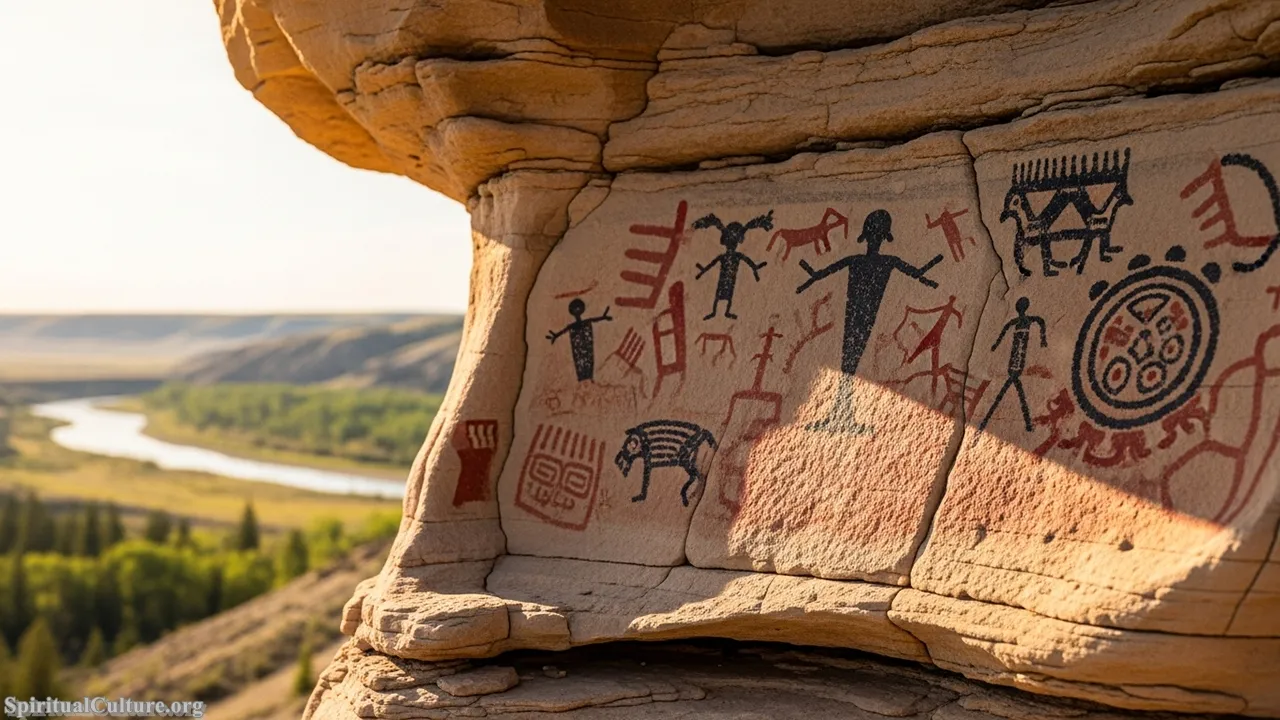
The immense spiritual impact of Áísínai’pi lies in its function as a sacred record keeper and a place of direct communication with the spirit world. The Blackfoot traditional belief is that as the older rock art erodes, the Spirits create new ones—a powerful concept of dynamic, living scripture. The ranking acknowledges the unparalleled artistic record combined with the spiritual sanctity of the Milk River Valley. As of the Current Time of Writing, the Blackfoot Confederacy guides the interpretive and preservation efforts, ensuring the spiritual narrative is told with fidelity and respect.
This site offers a powerful reflection on the endurance of spiritual communication. It teaches the moral lesson that the landscape itself is a holy text, capable of conveying profound truths across millennia. The unique geological features (hoodoos) and the rock art together form an integrated spiritual monument, demanding reverence for both the artistry of the ancestors and the natural forces that sustain the sacred space.
Cultural/Spiritual Highlights
- Largest Rock Art Concentration: Home to the most extensive collection of Indigenous rock art on the North American Plains.
- Living Scripture: The Niitsitapi view the cliff faces as places where spirits communicate through images.
- 2019 UNESCO Inscription: Recognized for its testimony to the spiritual life and traditions of the Plains Indigenous Peoples.
Top 2. Head-Smashed-In Buffalo Jump
Head-Smashed-In Buffalo Jump, a majestic cliff face in the foothills of the Rocky Mountains in Southern Alberta, stands as one of the world’s oldest, most extensive, and best-preserved sites illustrating the communal hunting techniques of the Plains Indigenous Peoples. Used for nearly 6,000 years, this UNESCO World Heritage Site (1981) is far more than an archaeological dig; it is the physical embodiment of a sophisticated, communal culture built on deep spiritual understanding of the bison (Iinnii) and the landscape.
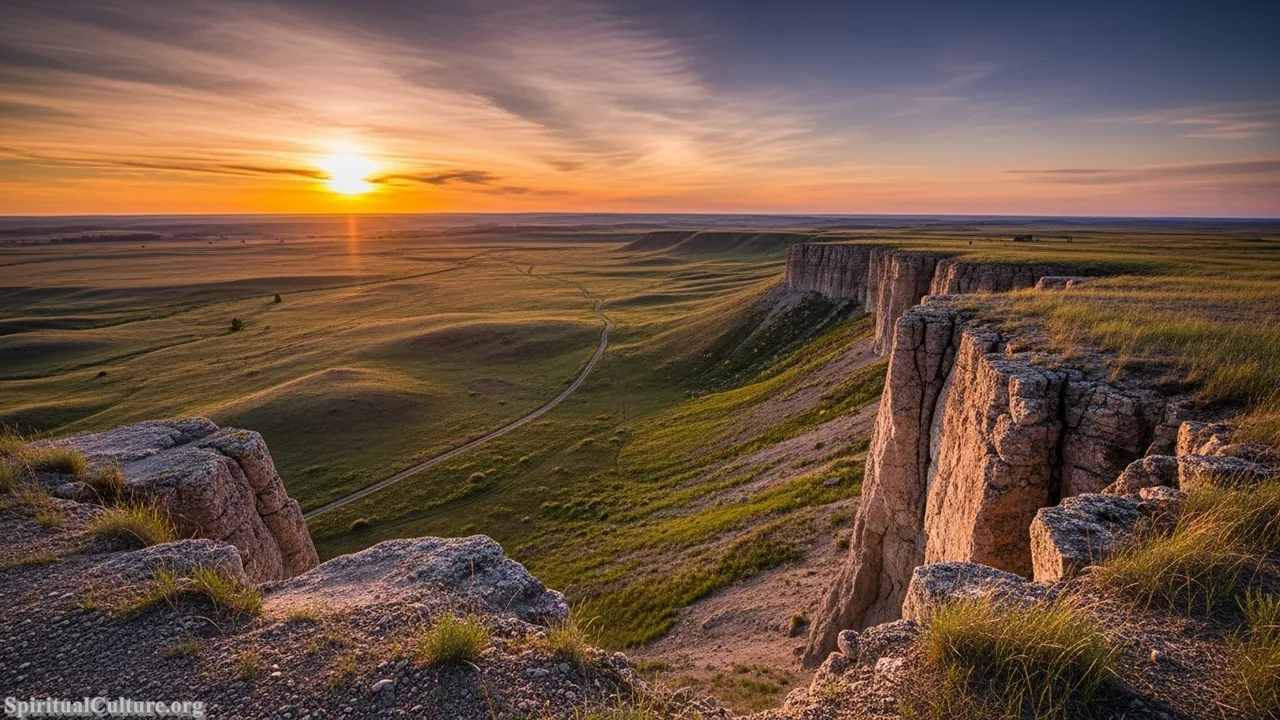
Its high ranking is due to the sheer archaeological depth and the spiritual sophistication of the event it represents. The bison hunt was not merely subsistence; it was a deeply ritualistic, communal, and spiritual undertaking, involving ceremonial leaders, medicine people, and Iikuni (Buffalo Runners). This site demonstrates a complex, sustainable relationship with a primary life source that required profound spiritual preparation and respect. As of the Current Time of Writing, the interpretive centre and programs are dedicated to sharing the cultural and spiritual context provided by the Blackfoot (Niitsitapi) Nation.
Head-Smashed-In offers a powerful reflection on the power of collective spiritual effort and sustainable resource use. The moral lesson is the spiritual principle of reciprocity: the buffalo gave its life for the people, and the people, in turn, respected the buffalo’s spirit and utilized every part of the gift. The site stands as a chilling, yet celebratory, monument to a time when humanity and the animal world were bound by an indispensable spiritual contract.
Cultural/Spiritual Highlights
- 6,000 Years of Use: One of the oldest examples of communal hunting, predating the Pyramids of Egypt.
- Ritualistic Hunt: The communal jump was preceded by complex spiritual ceremonies and leadership roles.
- Blackfoot Lore: Named for a Blackfoot legend about a young brave who was tragically buried under a pile of falling bison.
Top 1. SG̱ang Gwaay (Ninstints)
SG̱ang Gwaay, formerly known as Ninstints, is the most celebrated and spiritually resonant Indigenous cultural site in Canada. Located on an island in the Haida Gwaii archipelago off the coast of British Columbia, this former village of the Kunghit Haida is a UNESCO World Heritage Site (1981) that preserves the largest and finest collection of 19th-century monumental Haida mortuary and memorial poles in situ.

The supreme ranking is accorded because SG̱ang Gwaay represents the zenith of Haida monumental art and the most powerful tangible connection to the spiritual beliefs surrounding ancestry, prestige, and the connection between the living and the dead. These carved poles, weathering naturally back into the earth as of the Current Time of Writing, are not static art; they are spiritual biographies and heraldic registers that embody the Haida belief in the perpetual presence of ancestors. The village, though abandoned in the 1880s due to smallpox, remains a profoundly spiritual place guarded by the Haida Watchmen.
SG̱ang Gwaay offers a majestic reflection on the spiritual power of art and memory. It teaches an enduring moral lesson: that true heritage must be allowed to exist and decay with dignity, its protection being the act of respect and remembrance, not mere physical preservation. The powerful, silent sentinels of the poles, overlooking the sea, stand as the ultimate Spiritual Culture testament to the deep ancestral and spiritual values of the Haida Nation.
Cultural/Spiritual Highlights
- In-Situ Memorial Poles: Preserves the world’s most impressive collection of monumental 19th-century Haida poles in their original setting.
- Ancestral Portal: The poles function as physical links between the living community and their ancestral spirits.
- Haida Watchmen: The site is continually protected and interpreted by Haida community members, ensuring spiritual protocol is followed.
Conclusion
The Top 10 Indigenous cultural sites in Canada are not isolated landmarks, but integrated pieces of a vast, enduring spiritual tapestry. As explored by Spiritual Culture, these places—from the carved monuments of SG̱ang Gwaay to the ancient wisdom etched at Áísínai’pi—are powerful reminders that the land is infused with meaning and history. They challenge us to adopt a humanistic and profound perspective, one that sees cultural preservation as an essential act of spiritual reconciliation. In the Current Time of Writing, to celebrate these sites is to celebrate the resilience, knowledge, and spiritual depth of the First Nations, Inuit, and Métis peoples, whose ancient wisdom continues to offer light and guidance to the modern world.
